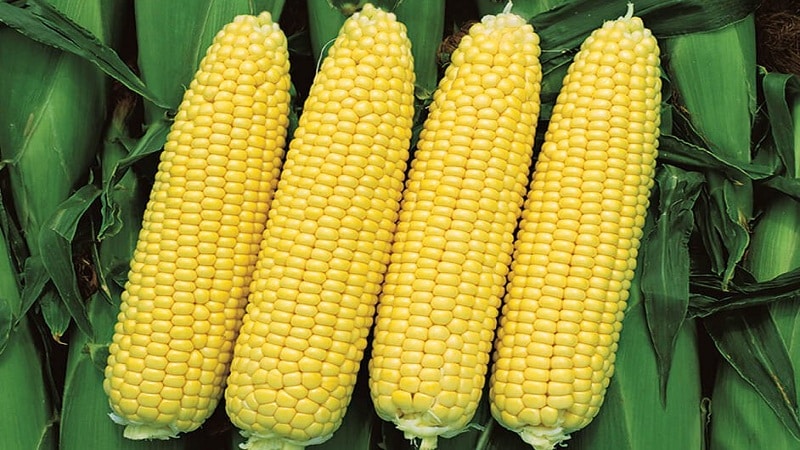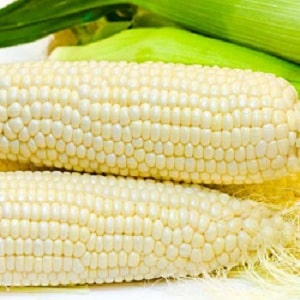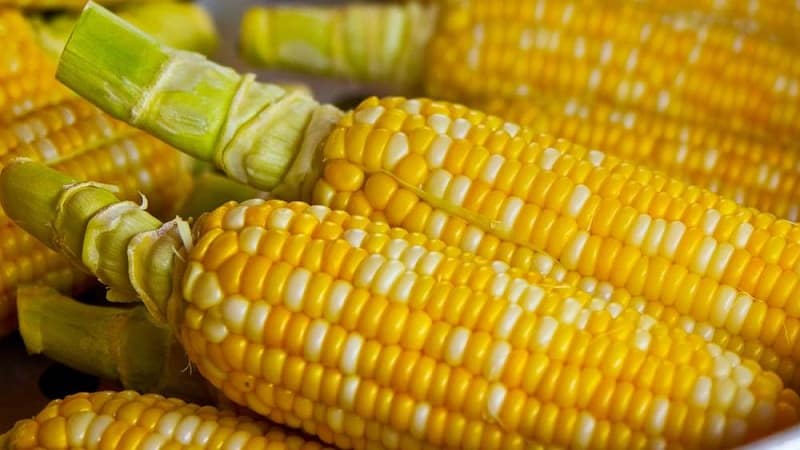Sweet corn: choosing the best variety and growing the dessert variety correctly
Corn is a plant unique in its chemical composition and nutritional value. The product appears on our tables at any time of the year and in any form. But we get the greatest benefit and pleasure from eating fresh and boiled sweet corn.
This article will be of interest to those who are interested in growing crops for their own needs or for sale. We will talk about the features of cultivation and give a description of several popular varieties of sweet corn.
Features of sweet corn and differences from other types
Sweet corn is an annual herbaceous plant reaching a height of 3 m. It has a stem of medium thickness, up to 8 cm in diameter. The female type flowers are collected in cobs, while the male type resembles fluffy panicles.
 The color of the grains varies from light yellow to golden, depending on the variety. Corn on the cob is very sweet, containing a lot of sucrose and little starch. They are consumed boiled, raw, and canned.
The color of the grains varies from light yellow to golden, depending on the variety. Corn on the cob is very sweet, containing a lot of sucrose and little starch. They are consumed boiled, raw, and canned.
In addition to sugar varieties, the following types are widespread:
- Bursting. It differs from sugar in its higher content of protein, fat and starch. Used for the production of popcorn, cereals, flakes. The culture produces a large number of ears with small grains in a dense shell.
- Dentoform. It is cultivated to produce grain, from which flour, cereals, alcohol and feed for farm animals are produced.All varieties of dent corn are classified as mid- to late-ripening. During the ripening process, a small depression is formed in the grains, which is why the plant got its name.
- Siliceous. The crop is grown to produce flour, cereals, corn sticks and flakes. The convex-shaped grains have a shiny and dense shell. Cobs have a lot of starch and protein.
- Stern. The crop is grown specifically to produce green mass, which is used as feed for animals and birds. Silage, meal, starch, alcohol, gluten, and oil are prepared from forage varieties. The grains are quite hard and tasteless, however, they are suitable for food.
Interesting fact. Corn cobs lose half their sweetness just six hours after harvest.
The photo shows sweet corn of the White Cloud variety.

Compound
Table of chemical composition of raw sweet corn.
| Name | Content | Norm |
| Vitamin A | 9 mcg | 900 mcg |
| Beta carotene | 0.047 mg | 5 mg |
| Vitamin B1 | 0.155 ml | 1.5 mg |
| Vitamin B2 | 0.055 mg | 1.8 mg |
| Vitamin B4 | 23 mg | 500 mg |
| Vitamin B5 | 0.717 mg | 5 mg |
| Vitamin B6 | 0.093 mg | 2 mg |
| Vitamin B9 | 42 mcg | 400 mcg |
| Vitamin C | 6.8 mg | 90 mg |
| Vitamin K | 0.3 mcg | 120 mcg |
| Vitamin PP | 1.77 mg | 20 mg |
| Potassium, | 270 mg | 2500 mg |
| Calcium | 2 mg | 1000 mg |
| Magnesium | 37 mg | 400 mg |
| Sodium | 15 mg | 1300 mg |
| Phosphorus | 89 mg | 800 mg |
| Iron | 0.52 mg | 18 mg |
| Manganese | 0.163 mg | 2 mg |
| Copper | 54 mcg | 1000 mcg |
| Selenium | 0.6 mcg | 55 mcg |
| Zinc | 0.46 mg | 12 mg |
KBZHU
Nutritional value of the product per 100 g:
- calorie content – 86 kcal;
- proteins – 3.27 g;
- fats – 1.35 g;
- carbohydrates – 16.7 g;
- fiber – 2 g;
- water – 76.05 g;
- ash – 0.62 g;
- starch – 5.7 g;
- water-soluble saccharides – 6.26 g;
- glucose – 3.43 g;
- fructose – 1.94 g;
- sucrose – 0.89 g.
Corn cobs are rich in essential and essential amino acids, saturated and unsaturated fatty acids.
Benefits and harms
Regular consumption of sweet corn brings tangible benefits to the body, which manifests itself in:
- normalization of metabolism;
- removing excess cholesterol;
- reducing blood glucose levels;
- strengthening the immune system;
- normalization of hormonal levels;
- reducing the risk of heart attacks, strokes and cancer;
- normalization of water and electrolyte balance;
- strengthening bone and muscle tissue;
- increasing hemoglobin levels;
- general rejuvenation of the body;
- improving intestinal motility;
- cleansing blood vessels;
- eliminating bile stagnation.
Reference. Corn cobs do not accumulate chemicals that are used to treat fields. Therefore, they can be consumed even raw.
Doctors advise people suffering from stomach diseases and obesity not to get carried away with corn.
In the first months of breastfeeding, you should avoid corn, as the product can cause colic and excessive gas in the baby.
Sweet corn varieties
There are many varieties and hybrids of corn, but the sweet varieties are the most popular among gardeners. We have compiled a list of the best high-yielding varieties of sweet corn.
Arkon f1
An early maturing hybrid of super sweet corn, intended for cultivation in the southern regions of Russia. Ears 22 -24 cm long ripen in 66-68 days. The color of the grains is bright yellow. The amount of sugars is 18%. The taste is sweet, the starch taste is completely absent. The variety is characterized by resistance to cold, drought and helminthosporium.
Morning song f1
The hybrid, characterized by high yield, ripens in 70-75 days. The cobs reach a length of 16-18 cm. The grains are sweet, juicy, and yellow in color. Used for consumption in boiled and canned form.
Baron f1
High-yielding hybrid, ripens in 62-65 days. The ears are smooth, equal in length (23-25 cm), sugar content 16%. The shade of the grains is dark yellow. The taste is sweet, without a starchy aftertaste. It is characterized by excellent keeping quality and transportability.
Gourmand
A simple early maturing hybrid of dessert corn. Suitable for cultivation on fertile and loose soil. Conical ears, 18-23 cm long, ripen in 72-75 days. Used for canning and boiled consumption. The grains are sweet, with delicate skin, yellow-orange in color.
Megaton F1
Late-ripening variety, the first harvest is harvested 85 days after emergence. The ears are conical in shape, up to 20 cm long. Characterized by resistance to drought, viral diseases, and fusarium. The taste is excellent, the grains have a delicate structure and yellow-orange color.
White cloud
Mid-season variety of sweet corn for cultivation in the southern regions. It is unpretentious in care, but “loves” warmth and moist soil. The cobs are slightly conical in shape, up to 22 cm long. The grains are sweet, pleasant to the taste, white-yellow in color. Used for consumption boiled. The harvest begins after 80 days.
Boston F1
A mid-ripening productive hybrid, ripens in 72-74 days from the moment of germination. The cobs grow 21 cm in length. The color of the grains is yellow, the taste is excellent. Suitable for canning and boiled consumption. The culture is thermophilic and does not tolerate shading.
Cupid
Early productive variety. The ears are conical in shape, 16 cm long. The grains are tender, sweet, yellow-orange in color. Taste qualities are high. Suitable for cooking, canning, freezing.
Delicatessen
An early ripening variety, ripens in 65-70 days. The cobs are cone-shaped, no more than 17 cm long. The grains are sweet and contain a lot of sugars and fiber. Suitable for pickling, baking, boiling, freezing.
Features of cultivation

The plant loves sun, moderate watering and fertilizing. The technology for growing sweet corn is not particularly complicated, but requires compliance with a number of rules to obtain a rich harvest:
- Planting begins in the first ten days of May in the southern regions, and at the beginning of summer in central Russia.
- Choosing the right variety is one of the main conditions for obtaining the expected result.
- Sow in areas protected from drafts, with sufficient lighting.
- The soil must be fertile and allow moisture and air to pass through. Swampy soils are not suitable for growing corn.
- Heavy and clogged soil, poor in nutrients, is put in order: peat, sand, and organic fertilizers are added. Acidic soil is treated with lime, sandy soil is enriched with organic matter. The earth is dug up using a bayonet shovel and loosened.
- Sweet corn is planted in fields where potatoes, legumes, melons or tomatoes were previously grown.
- Before sowing, the grains are sorted and whole and large-caliber seeds are deposited. Testing for germination is carried out by soaking the material in a low concentration saline solution. The settled seeds are used for planting.
- Disinfection of grains is carried out using a concentrated solution of potassium permanganate.
- Seeds are sown in furrows 7-8 cm deep, with an interval of 10-15 cm.The beds in the neighborhood are formed at a distance of 40 cm. This ensures better cross-pollination.
- In practice, the square-cluster sowing method is often used. The plot of land is divided into squares and holes up to 10 cm are dug. Seeds are planted in them and covered with earth.
- Planting sweet corn is possible using seedlings. Seeds are sown in pots with a nutrient substrate in early spring. Seedlings are planted with the onset of warm weather.
- From the moment of rapid growth, the corn is hilled, weeded and fertilized. Watering is carried out twice a week.
- Nitrogen, phosphorus, potassium, and compost are used as fertilizing.
- Stems are tied up if varieties are prone to lodging.
- From time to time, pinching is carried out, leaving 2-3 ears.
Applications of sweet corn
Sweet corn is widely used for culinary purposes. Young cobs are eaten fresh, boiled in water or steamed, baked in the grill and over a fire, pickled for the winter, frozen in the freezer. The grains are suitable for canning, making soups and porridge, and salads. Bakery products are baked from flour, corn tortillas, cupcakes, and muffins are prepared.
We offer a version of the recipe for home canned dessert corn.
Ingredients per 0.5 liter jar:
- corn cobs;
- salt – 1 tsp., l.;
- sugar – 2 tsp; l;
- table vinegar 9% – 15 ml.
Boil the corn in water or steam, cut off the kernels with a sharp knife and fill the container. Add salt, sugar and vinegar. Pour boiling water over it, cover with tin lids and place to sterilize in a wide saucepan for three hours. Then roll it up with a key and turn it over. Workpiece excellent stored in the pantry, jars don't explode.
Contraindications
Corn on the cob is prohibited for those who suffer from:
- gastritis, ulcers in the acute stage;
- varicose veins, thrombosis, thrombophlebitis;
- allergy to the product;
- increased blood clotting.
Read also:
How corn is grown and harvested for silage.
Conclusion
Corn is an unpretentious crop to grow, but grows best in the southern regions of the country. Sugar varieties are characterized by high taste and nutritional value, have a rich chemical composition and, when consumed correctly, bring only health benefits.